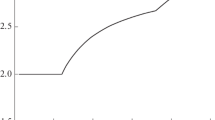Abstract
Recently, the incidence matrices of some block designs have been considered as the mother matrices of some quasi-cyclic (QC) low-density parity-check (LDPC) codes with maximum girth 20. In fact, the authors have introduced a deterministic algorithm which randomly, by a computer search, generates the slope vectors corresponding to the codes with desired girth, not greater than 20. In this paper, by rearranging the blocks of each block design, some slope vectors are proposed with an explicit method such that their corresponding QC LDPC codes have girth 8. Then, for each slope vector S, the lower bound Q(S) is found such that the QC LDPC codes with slope vector S and block size N, N ≥ Q, have girth at least 8.
Similar content being viewed by others
References
Ammar B, Honary B, Kou Y, Xu J, Lin S (2004) Construction of low-density parity-check codes based on balanced incomplete block designs. IEEE Trans Inf Theory 50(6):1257–1268
Chen C, Bai B, Wang X (2010) Construction of nonbinary quasi-cyclic LDPC cycle codes based on singer perfect difference set. IEEE Commun Lett 14(2):181–183
Fossorier MPC (2004) Quasi-cyclic low-density parity-check codes from circulant permutation matrices. IEEE Trans Inf Theory 50:1788–1794
Gallager RG (1962) Low density parity check codes. IEEE Trans Inf Theory 8:21–28
Gholami M, Alinia M (2015) High-performance binary and nonbinary LDPC codes based on affine permutation matrices. IET Commun 9(17):2114–2123
Gholami M, Samadieh M (2013) Convolutional cylinder-type block circulant cycle codes. Trans Comb 2(2):9–17
Gholami M, Samadieh M, Raeisi G (2013) Column-weight three QC LDPC codes with girth 20. IEEE Commun Lett 17(7):1439–1442
Huang CM, Huang JF, Yang CC (2008) Construction of QC-LDPC codes from quadratic congruences. IEEE Commun Lett 12(4):313–315
Karimi M, Banihashemi AH (2013) On the girth of quasi cyclic protograph LDPC codes. IEEE Trans Inf Theory 59(7):4542–4552
Kim JL, Peled UN, Perepelitsa I, Pless V (2002) Explicit construction of families of LDPC codes with girth at least six. Proc. 40th Annu. Allerton Conference on Communication, Control and Computing, Monticello, pp 1024–1031
Kschischang FR, Frey BJ, Loeliger HA (2001) Factor graphs and the sum-product algorithm. IEEE Trans Inf Theory 47:498–519
Lally K (2007) Explicit construction of type-II QC LDPC codes with girth at least 6. IEEE International Symposium on Information Theory, ISIT 2007:2371–2375
Lan L, Zeng L, Tai YY, Chen L, Lin S, Ghaffar KA (2007) Construction of QC-LDPC codes for AWGN and binary erasure channels: a finite field approach. IEEE Trans Inf Theory 53(7):2429–2457
McEliece RJ, Mackay DJC, Cheng JF (1998) Turbo decoding as an instance of pearl’s belief propagation algorithm. IEEE J Sel Areas Commun 16:140–152
Myung S, Yang K (2005) A combining method of quasi-cyclic LDPC codes by the Chinese remainder theorem. IEEE Commun Lett 9(9):823–825
O’Sullivan ME (2006) Algebraic construction of sparse matrices with large girth. IEEE Trans Inf Theory 50(8):1788–1793
Tanner RM (1981) A recursive approach to low complexity codes. IEEE Trans Inf Theory IT-27:533–547
Tanner MR, Sridhara D, Sridharan A, Fuja TE, Costello DJ (2004) LDPC block and convolutional codes based on circulant matrices. IEEE Trans Inf Theory 50:2966–2984
Zhang G, Sun R, Wang X (2013a) Several explicit constructions for (3, L) QC-LDPC codes with girth at least eight. IEEE Commun Lett 17:1822–1825
Zhang G, Sun R, Wang X (2013b) Construction of girth-eight QC-LDPC codes from greatest common divisor. IEEE Commun Lett 17(2):369–372
Acknowledgments
We would like to thank the anonymous referees for their helpful comments. This work was supported in part by the research council of Shahrekord University. Moreover, the first author was in part supported by a Grant from IPM (No. 93050065).
Author information
Authors and Affiliations
Corresponding author
Rights and permissions
About this article
Cite this article
Gholami, M., Gholami, Z. An Explicit Method to Generate Some QC LDPC Codes with Girth 8. Iran. J. Sci. Technol. Trans. Sci. 40, 145–149 (2016). https://doi.org/10.1007/s40995-016-0008-9
Received:
Accepted:
Published:
Issue Date:
DOI: https://doi.org/10.1007/s40995-016-0008-9




